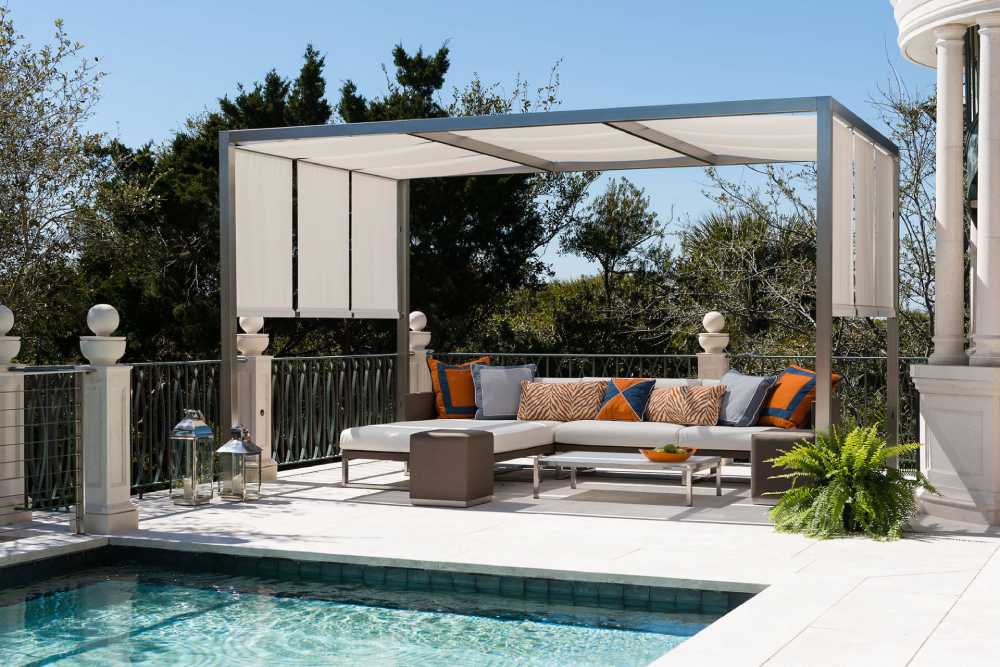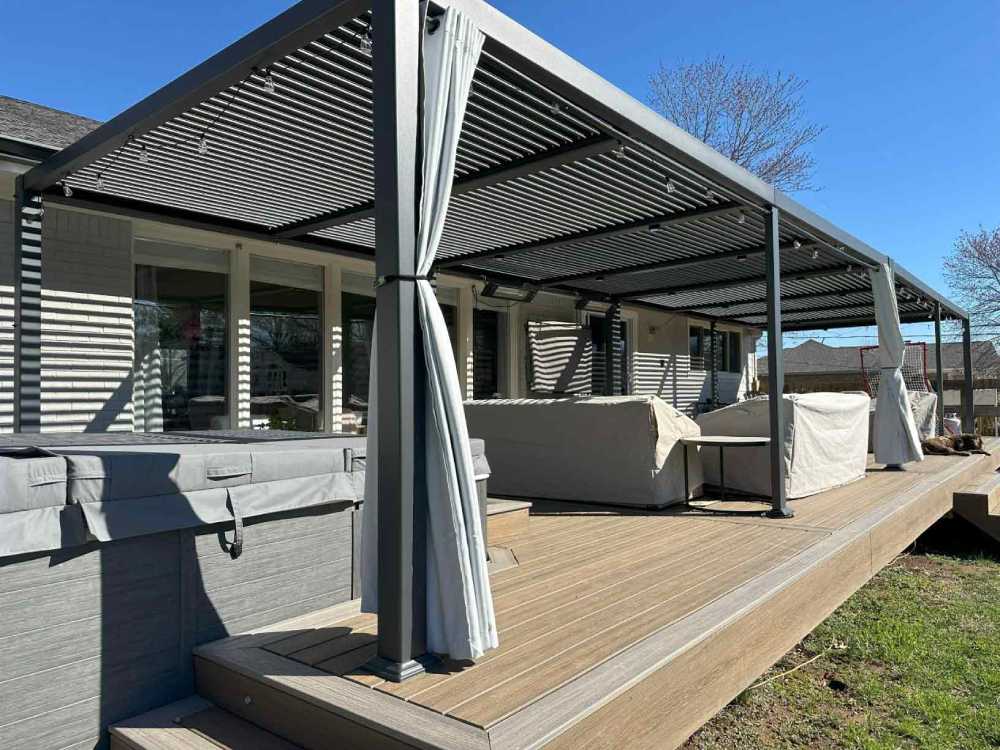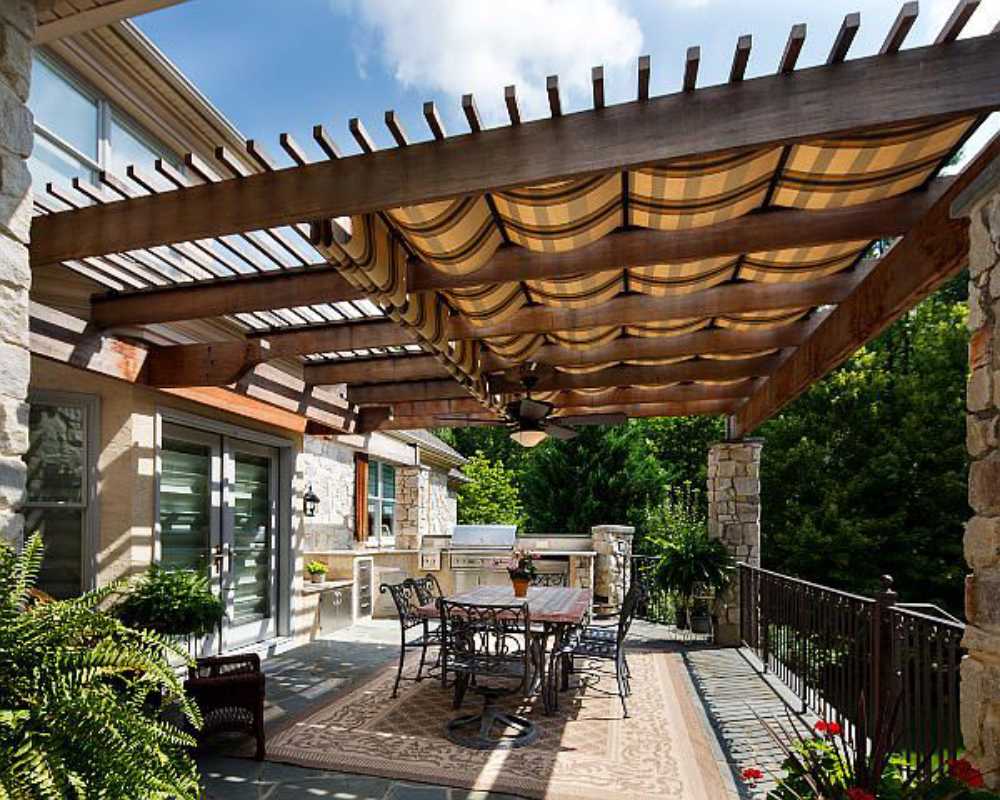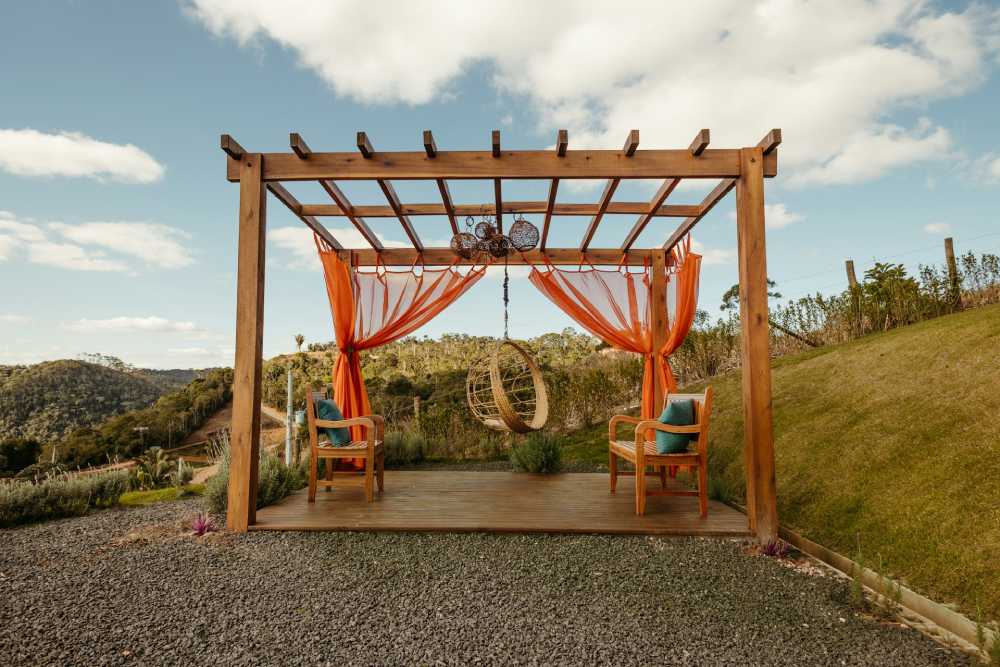Recent advances in technology have revolutionized pergola roof designs. Modern systems now open and close with just a button press. Homeowners can pick between classic wood charm or sleek automated solutions that fit their lifestyle perfectly.
Pergola roofing comes in many exciting options. You’ll find waterproof designs and cutting-edge roof styles that work for any home. The choices are endless – from solar panels that save energy to glass roofs that let natural light flood in. Some designs even feature living roofs with plants that create a natural feel. These roof covers make outdoor spaces more enjoyable all year round, whatever the weather throws at you.
This piece takes a closer look at the most practical and eye-catching pergola roof designs. You’ll find everything you need to know about picking materials, matching designs, adding smart features, and keeping your pergola in top shape.
Modern Pergola Roof Options
The perfect outdoor space begins with the right pergola roof. Today’s modern pergola roof designs have evolved by a lot, giving homeowners better control over their outdoor environments.
Latest trends in pergola roofing
Smart technology leads the way in pergola roofing innovations. Homeowners can adjust their pergola’s coverage through motorized louvered roof systems with a simple button touch or voice command. These advanced systems adapt automatically to weather changes and ensure year-round comfort.

Mixing different roofing styles creates another exciting trend. The combination of pergola and pavilion designs results in stunning and practical outdoor living spaces. Your backyard retreat can blend beauty and function through this innovative approach.
Popular materials and their benefits
Modern pergola roofs use various materials that each bring unique advantages:
- Aluminum: Lightweight, rust-resistant, and virtually maintenance-free
- Fiberglass: Smooth surface, maintenance-free, and can span up to 26 feet
- Polycarbonate: Allows natural light while blocking UV rays, available in various colors
- Vinyl: Budget-friendly option with minimal maintenance requirements
Material choice shapes both your pergola’s look and its durability. Aluminum works great in coastal areas because it resists corrosion effectively.
Cost considerations for different options
Your pergola roof investment varies based on materials and features. Here’s what you can expect:
- Basic Options: Retractable canopy roofs range from USD 575 to USD 1,450
- Mid-Range Solutions: Manual louvered systems cost between USD 45 to USD 110 per square foot
- Premium Choices: Smart automated pergolas range from USD 75 to USD 175 per square foot
A standard-sized pergola with premium features typically costs between USD 8,000 and USD 15,000. This price includes delivery and installation. Additional accessories or larger sizes will increase the cost.
DIY enthusiasts can choose prefabricated pergola kits as an economical option. These kits range from USD 500 to USD 4,000 depending on materials and features.
Choosing the Perfect Pergola Roof Design
Choosing the right pergola roof design creates harmony between your outdoor structure and your home’s architecture. You should match your pergola’s style with your house’s architectural elements to blend indoor and outdoor spaces naturally.
Matching your home’s architectural style
Each home style needs a specific pergola approach. Mediterranean homes look best with pergolas that mirror their esthetic through proportional scaling and complementary sand-colored finishes. Contemporary ranch homes work well with horizontal lines and broad, open spaces that highlight their modern character. Modern farmhouse designs pair perfectly with pergolas that mix traditional and contemporary elements – especially those with sleek black frames against white louvers.
Color and material coordination tips
Colors and materials can vastly improve a pergola’s visual appeal. Neutral pergola colors like beige, gray, and white never go out of style. White pergolas work great for homes in warmer climates because they reflect heat well. Black or charcoal gray creates striking contrasts with surrounding greenery, though these colors absorb more heat.
A good color scheme should match:
- Your home’s exterior palette
- Surrounding landscape elements
- Architectural trim details
- Outdoor furniture colors
Impact on property value
Well-designed pergolas can bring substantial returns on investment. Most homeowners see a 1.5x to 2x return on their pergola investment within a year of construction. Pergolas that meet building codes (105 mph or more) add the most value to properties.
These factors affect property value:
- Quality of materials used
- Integration with existing architecture
- Overall design esthetics
- Functionality and versatility
A pergola becomes valuable when it creates an inviting outdoor living space that potential buyers can picture themselves enjoying. The highest return on investment comes from focusing on both looks and practical use.
Waterproof Pergola Roof Solutions
Homeowners who want to enjoy their pergolas all year round need to protect their outdoor spaces from unpredictable weather. Without doubt, the right mix of materials and good drainage can change a simple pergola into a weather-resistant sanctuary.

Best materials for weather protection
The weather resistance of several materials makes them stand out in different climates:
- Polycarbonate panels: Semi-transparent and able to block UV rays while letting natural light through
- Aluminum louvered roofs: Are great at keeping water out and need little maintenance
- Glass panels: Give elegant protection and let in maximum natural light
- Metal roofing: Will give a long life and needs minimal upkeep
Drainage system considerations
A quick drainage system is the foundation of any waterproof pergola design. A well-laid-out system has:
- Integrated gutters along the pergola edges
- Downspouts hidden within support posts
- Water collection troughs under adjustable louvers
Modern pergolas now blend smart drainage solutions that channel water through internal post channels. This prevents splashing and overflow effectively. In spite of that, these systems must be installed properly to work at their best.
Installation requirements
A successful pergola roof installation needs careful attention to several vital factors. Quality waterproof sealants on joints and connections will keep moisture out completely.
Professional installation needs:
- Exact measurements and precise cutting of roofing materials
- Water-resistant adhesive application
- Proper ventilation system setup
The installation process should check:
- All gaps and joints are sealed properly
- Drainage components are positioned correctly
- Water runoff has adequate slope
Homeowners should know that some materials, like louvered systems, must be installed by professionals to keep warranty coverage and ensure everything works right. Some advanced systems, like those from StruXure, have sensors that close the roof as soon as rain starts.
Smart Pergola Roof Cover Ideas
Smart technology has changed the way we look at modern pergola roof ideas. It brings better control and comfort to outdoor living spaces. In fact, homeowners can now enjoy sophisticated features that were once found only indoors.
Retractable roof systems
Modern pergola designs come with motorized louvered roofs that can rotate up to 170 degrees. You can control these systems with remote controls, smartphone apps, and voice commands through popular platforms like Amazon’s Alexa and Google Assistant. The high-end systems now give you:
- Weather sensors that close automatically when it rains
- Wind detection to adjust louvers
- Temperature monitoring to prevent snow buildup
- Built-in drainage systems
- Smart home compatibility
Automated climate control options
Modern pergola roof designs now blend intelligent climate management features. These systems adjust automatically based on weather conditions and provide comfort all year round. Smart sensors watch different environmental factors and react quickly:
- Rain sensors close the roof automatically
- Wind sensors move louvers to avoid damage
- Temperature sensors handle snow buildup
- Humidity sensors keep air flowing properly
These automated features are a great way to get more from your outdoor spaces. You can use them whatever the weather.
Lighting integration possibilities
Integrated lighting turns pergolas into magical outdoor retreats at night. The newest lighting options include:
- Perimeter lights to create a magical glow
- Louvered lights that help you see tasks clearly
- Strategic spotlights that make decorative patterns
- Post-mounted sconces for soft lighting
Smart pergola systems let you control the lighting mood through mobile apps. LED options give you energy-efficient light with different colors and dimming features.
These smart features create exciting new possibilities for pergola roof designs. You can customize your outdoor spaces exactly how you want them. From adjusting shade levels to creating the perfect evening atmosphere with integrated lighting systems, the options are endless.
Smart pergola solutions boost property value. The automated features make daily life more comfortable and catch the eye of potential buyers who want modern outdoor living solutions.
Creating Your Dream Outdoor Living Space
You can turn your pergola into a welcoming outdoor sanctuary with the right mix of furniture, greenery, and entertainment features. The perfect blend of these elements creates a space that feels like your home extends naturally outdoors.

Furniture and decor selection
Your pergola’s main purpose should guide your outdoor furniture choices. Here are the key pieces you’ll need:
- Comfortable seating options (plush sofas, Adirondack chairs)
- Dining sets for alfresco meals
- Storage solutions for cushions and accessories
- Weather-resistant accent pieces
- Outdoor rugs to define spaces
Outdoor-specific fabric elements help prevent color fading and weather damage. Adding throw blankets and outdoor pillows makes the space more comfortable while keeping your design cohesive.
Plant integration ideas
Plants can dramatically change your pergola’s appeal. Here’s a smart way to place your greenery:
| Location | Plant Type | Benefits |
|---|---|---|
| Perimeter | Container blooms | Defines space |
| Vertical | Climbing vines | Natural shade |
| Overhead | Hanging baskets | Visual interest |
| Ground level | Hardy grasses | Privacy screen |
Morning glory vines create a beautiful natural canopy, while drought-resistant grasses provide year-round privacy with little maintenance. Flowering vines that climb up and around your pergola add both beauty and function.
Entertainment setup suggestions
Your pergola can house various entertainment options. A well-placed TV or projector system turns the area into an outdoor theater. Mount the screen near a corner support beam to ensure it stays protected from the elements.
Make your entertainment setup better with:
- Integrated speakers for immersive sound
- Ambient lighting for evening enjoyment
- A dedicated snack area or bar cart
- Storage solutions for electronics
String lights overhead make outdoor activities more enjoyable. A small sink and fully stocked refrigerator can turn your space into a premium outdoor living area.
Well-placed pendant lights above dining or seating areas keep the space functional after dark. A firepit surrounded by comfortable seating creates the perfect spot for evening talks and s’mores.
Pergola Roof Ideas Frequently Asked Questions
What is the best type of roof for a pergola?
The best type of roof for a pergola depends on its intended use and the climate in which it is built. Polycarbonate panels are a popular choice because they allow natural light while providing protection from rain and UV rays. Other pergola roof ideas include retractable canopies, thatch roofing, or metal sheets for a more durable and modern look.
How to cover the roof of a pergola?
There are several pergola roof cover ideas that can enhance both function and aesthetics. Options include fabric canopies, metal panels, or corrugated plastic sheets to provide shade and rain protection. Some homeowners also opt for climbing plants or wooden slats, which offer partial shade while maintaining an open feel.
Should you put a roof on a pergola?
Adding a roof to a pergola depends on how you plan to use the space. A roof can provide shade and protection from the elements, making the area more comfortable in various weather conditions. However, some people prefer an open-top pergola for a more airy and natural outdoor experience.
How to make a pergola roof waterproof?
To make a pergola roof waterproof, you can install clear polycarbonate panels, metal sheets, or waterproof fabric covers. Another effective method is adding a sloped design to allow rainwater to run off rather than pooling on the surface. Exploring waterproof pergola roof ideas can help ensure your outdoor space stays dry and functional.
Does a pergola roof need a pitch?
While a pergola roof does not always need a pitch, it is recommended if you want to prevent water accumulation. A slight slope helps with drainage, reducing the risk of water damage or leaks. Many modern pergola ideas with roof designs incorporate a subtle angle to improve functionality.
What is the point of a pergola without roof?
A pergola without a roof creates an open-air environment while providing structure and style to an outdoor space. It can serve as a decorative element, support climbing plants, or define an area for relaxation and entertainment. Some homeowners prefer a roofless pergola for its minimal maintenance and natural aesthetic.
Can I use 2×4 for pergola roof?
Yes, you can use 2x4s for a pergola roof, but they may not be strong enough to support heavy roofing materials. If you plan to use them, consider spacing them closely together or reinforcing them with additional beams. For a more durable structure, 2×6 or larger boards are often recommended.
How high should a pergola roof be?
A standard pergola roof is usually between 8 to 12 feet high, depending on the desired level of openness and the overall design. A taller pergola can create a more spacious feel, while a lower one provides more shade and a cozier atmosphere. The height should also complement the surrounding structures and landscape.
What angle should a pergola roof be?
The angle of a pergola roof depends on its purpose and the local climate. A pitch of at least 5 to 15 degrees is recommended for effective water runoff. If you’re considering modern pergola ideas with roof structures, ensure the angle suits both aesthetics and functionality.
What wood do you use on top of a pergola?
Common woods used for pergola roofs include cedar, redwood, and pressure-treated pine due to their durability and resistance to weather. Cedar and redwood naturally resist rot and insects, making them excellent choices for outdoor structures. Hardwoods like teak or ipe can also be used for a more luxurious look.
Why is pergola so expensive?
Pergolas can be expensive due to the cost of materials, labor, and customization. High-quality woods, metal framing, and durable roofing options increase the price, as does professional installation. Custom designs and premium finishes can also contribute to the overall cost.
What pergola material lasts longest?
Metal, such as aluminum or steel, lasts the longest due to its resistance to rot, insects, and weather damage. Vinyl is another long-lasting option that requires minimal maintenance. If you prefer wood, cedar and redwood offer the best durability with proper care.
What is the top of a pergola called?
The top of a pergola is called the rafters or purlins, depending on the structure. Rafters run the length of the pergola and provide structural support, while purlins are smaller cross beams that add shade and design appeal. Choosing the right materials for these elements is key when exploring pergola ideas with roof structures.
